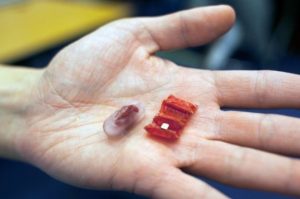Research performed at three major universities and research centers from around the world have met with spectacular success in using small origami robots to retrieve items from a stomach. The remarkable experiments involved a folded origami robot that is encased in a capsule that is then swallowed by the patient. When the robot gets to the stomach, it is released and it unfolds. In early experiments, researchers have had the robot retrieve both a button and a tiny battery.
The experiments were used with simulation of a stomach and an esophagus and the robot was maneuvered into position by the use of magnetic fields located outside of the stomach to move it and get it to retrieve the objects. The work was performed by separate teams at the University of Sheffield (England), MIT and the Tokyo Institute of Technology.
The work has been a building upon the research of two scientists at MIT in computer sciences and artificial intelligence. The scientists wanted to create a robotic situation where the robot could be free to maneuver without having to be attached to a tether like device. The robot is an advance on one developed last year and the researchers explain that the origami robot moves in a “stick-slip” type of motion. The robot adheres to a surface where it is by the use of friction and then is let lose again when there is movement on the part of the human who dislodges it from where it had stopped to work.
The new origami type of design has allowed the robot to become more flexible than the older model which had been made from Mylar. The researchers experimented with many types of materials to try and get the consistency correct. They finally settled on pig intestine for its flexibility as well as strength and for the ability to navigate through water and other stomach fluids.
The inside of the tiny folded origami robot lays an equally tiny magnet that allows it to be controlled from the outside by a stronger magnetic field.
PHOTO CREDIT: Melanie Gonick / MIT

